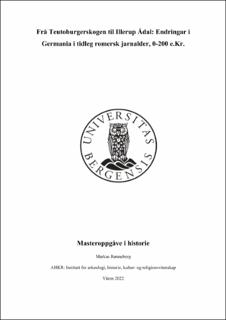| dc.description.abstract | This thesis examines changes in the Germanic society during the early Roman Iron Age, from approximately 0 to 200 A.D. This is viewed through the lens of two case studies – the Battle of the Teutoburg Forest and the weapon deposits in Illerup Ådal on the west coast of Jutland, dating from 200-500 A.D. My primary argument is that the Germanic society underwent both social, political and to an extent local, economic changes, and that these would later lead to the creation of larger and more powerful confederations of warriors and tribes. The first chapter explores the roman ethnographic tradition and its source material. It examines how the authors of the ancient world viewed the untamed North (Ultima Thule), the very term German – in opposition to romans – as well as how the Germanic society might have looked like in the period spanning from Gaius Julius Caesar to Publius Cornelius Tacitus (ca. 50 B.C. - 100 A.D.). I also touch upon the topic of Romanization, a much debated term in this day and time. The second and third chapter respectively deal with the two case studies. These cases have previously not been examined thoroughly side by side. Therefore, by utilizing these two areas of research as case studies, my intention is to show that modern archaeology may work as a window into the past, which is partly independent of the roman ethnographic tradition. In all three chapters I critically examine the available source material. This include both the classic roman literary texts, a wide variety of archaeological material and relevant excavation reports. I include modern interpretations and aim to give an overview of the current state of affairs within the field of research. Firstly, I examine how the picture of Germanic society – evoked from the roman literary sources – upholds when faced with modern archaeology. Here I build upon recent academic discourses and developments, including the material and the ethnographic, while also including new perspectives on the northern barbarians of the Roman Iron Age. Secondly, I ask what changes we can observe in the Germanic society when faced with Rome in the context of the aforementioned case studies; the battle of the Teutoburg Forest and the bog deposits in Illerup Ådal. My aim in doing so is to track changes and developments in Germania further back than previously emphasized. I hope this study will be a helpful addition to current debates. | |
